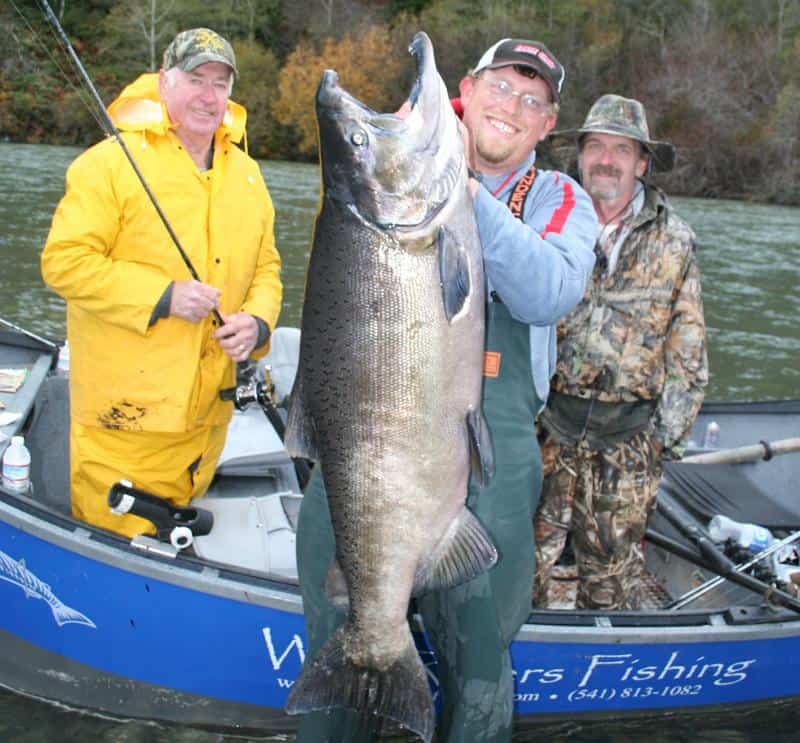Salmon are one of the most sought-after prizes for anglers.
Catching something that fights with wild abandon and then tastes just as good smoked as it does grilled with lemon and butter is a true calling.
Salmon fill a vital part in the lives of Native Americans on the Pacific Coast, who to this day hold these fish in the very highest regard and use the salmon runs to ensure their way of life.
The anglers in Europe spend inordinate amounts of time and money to be one of the lucky few to land a salmon during the Atlantic runs.
Some East Coast rivers get their share of salmon during their runs, but nowhere in the U.S. are salmon so prized among anglers as from Northern California through the Pacific Northwest and into Alaska.
Fisheries management has figured out ways to introduce ocean-bound salmon to lakes and reservoirs across the west, having them live their entire lifecycles in freshwater.
Kokanee are brilliant fighters with some of the best tasting meals provided in landlocked states, and Chinook, coho and other typically anadromous salmon also are stocked in lakes ranging from West Coast water storage reservoirs to the Great Lakes.
Before we tell you how to catch them, here is a quick look at the five main species of West Coast salmon.
Chinook Salmon
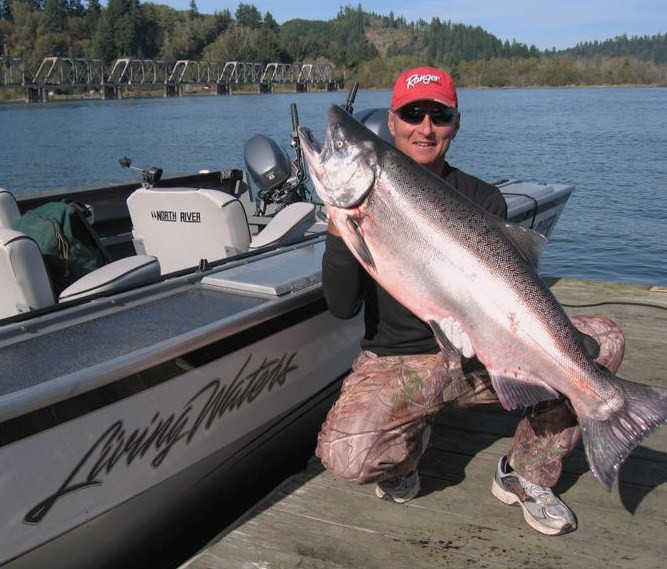
The Chinook is the big daddy of Pacific salmon. Its most common nickname is the king salmon, due both to its size and taste.
These aggressive fish get big and will ruin a pop gear set-up in seconds.
Depending on the run, Chinook might average anywhere from 10 to over 20 pounds, with catches over 30 pounds fairly regular and salmon above 40 and even 50 pounds or more pounds possible.
Before entering freshwater for the spawn, Chinook salmon have a purple hue across their upper backs with silver sides, along with some spots and often a black gumline.
When entering freshwater, Chinook eventually darken and start displaying a red line along their sides.
Most Chinook spawn in gravel beds found in medium-sized or larger waters, but they also will muscle their way into smaller streams, sometimes with their broad backs jutting out of the water while crossing shallow riffles.
There are different runs of Chinook salmon, depending on location. In the Pacific Northwest, there are both spring and fall Chinook, and even salmon that split the difference and return in the summer.
Some of these Chinook spawn within a few miles of the ocean, while others migrate hundreds of miles inland, as far east as Idaho. Regardless of when they start their migration, most Chinook spawn in the fall or in following months.
Coho Salmon
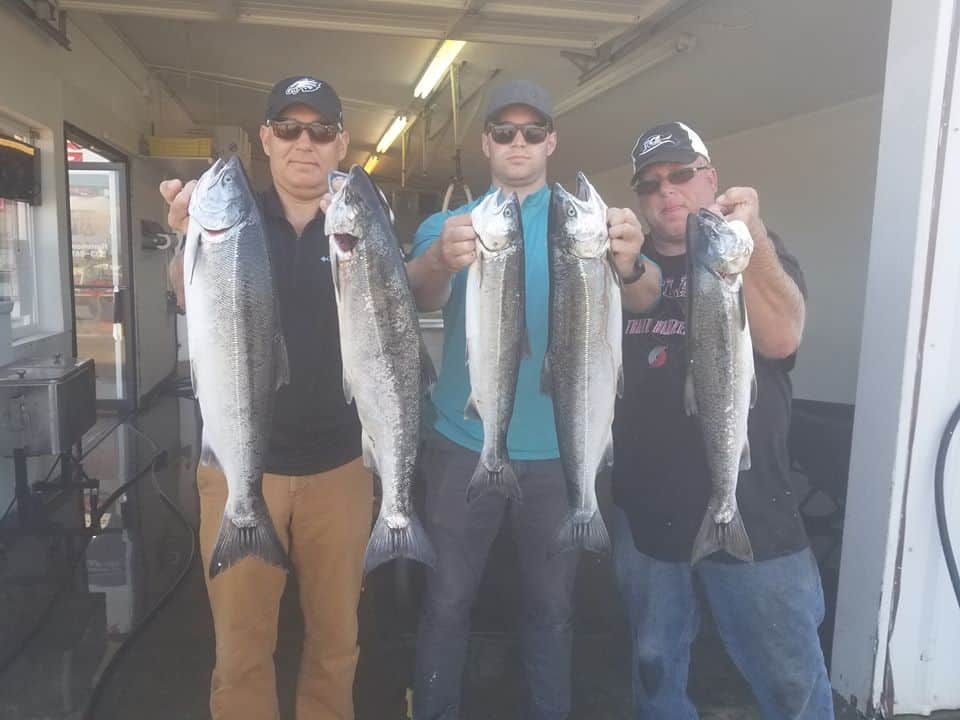
Coho, or silver, salmon range from California into Alaska. The majority will be caught between the Central Oregon Coast and Southeast Alaska.
When entering freshwater from the ocean, silvers develop a hooked jaw and turn a reddish maroon color.
With a habit of leaping like electricity on the end of a line, and providing a light, pleasant taste on the table, coho are a popular gamefish.
Coho are most common in coastal streams, although a few runs can travel quite far inland via the Columbia or other major rivers that Chinook also use.
However, while they return to many of the same rivers, coho salmon are more likely to migrate into upper watersheds and smaller tributaries to spawn, where they often join steelhead and resident trout.
Coho are among the best jumpers in the salmon family, and they have no problem scaling rapids to reach prime spawning redds.
Silvers are famous for waiting in saltwater bays until a good rainstorm to run upstream, often in mass numbers that fill small rivers.
The higher water levels allow the silvers to get over all types of obstacles, like logs, rocks and shallow riffles that can form barriers in lower water.
Sockeye Salmon
Next up are the sockeye salmon.
Spreading from the northern edge of Oregon far into Alaska, these smaller beauties are what many people associate with salmon.
They get the traditional green head and red bodies when heading up to spawn and are often the leaping salmon that Alaskan bears are snatching out of the air in those wildlife videos.
Abundant and excellent eating, ocean-going sockeye salmon also have a smaller landlocked form known as a kokanee, which are more similar in size to many trout.
Kokanee are indigenous to some West Coast lakes, sometimes where their migrations have been blocked by natural events such as landslides.
Wildlife agencies have spread these popular fish far beyond their ancestral homes to keep and cold lakes in mountainous or northerly states.
Anadromous sockeye salmon have a stronger, classic salmon flavor. They are among the most commercially caught of salmon, especially in northern areas, although sport anglers also like to catch them.
Sockeye like large rivers to run up and tend to spawn in and around mountain lakes. Their fry require a lake to grow up in for the first few years before making the return trip to the ocean.
Pink Salmon
Pink salmon may be on your list, and if so, check for the next run. They generally visit Washington through Alaska and appear every other year.
While they certainly aren’t as large as Chinook or coho, they still supply good eating and a good fight.
Male pink salmon have a humpback that develops during the spawning season. It has earned them the nickname humpback salmon, or humpies.
Pink salmon offer the smallest fall run and only return to the area every other year. In Washington, nearly all pink salmon return in odd-numbered years, arriving in the late summer. Good runs can mean lights out fishing, but runs have suffered in recent years.
Pink fry move into saltwater right after emerging from the egg, so the closer to the ocean they can spawn, the better, so look for them in lower reaches of rivers that have humpy runs.
Chum Salmon
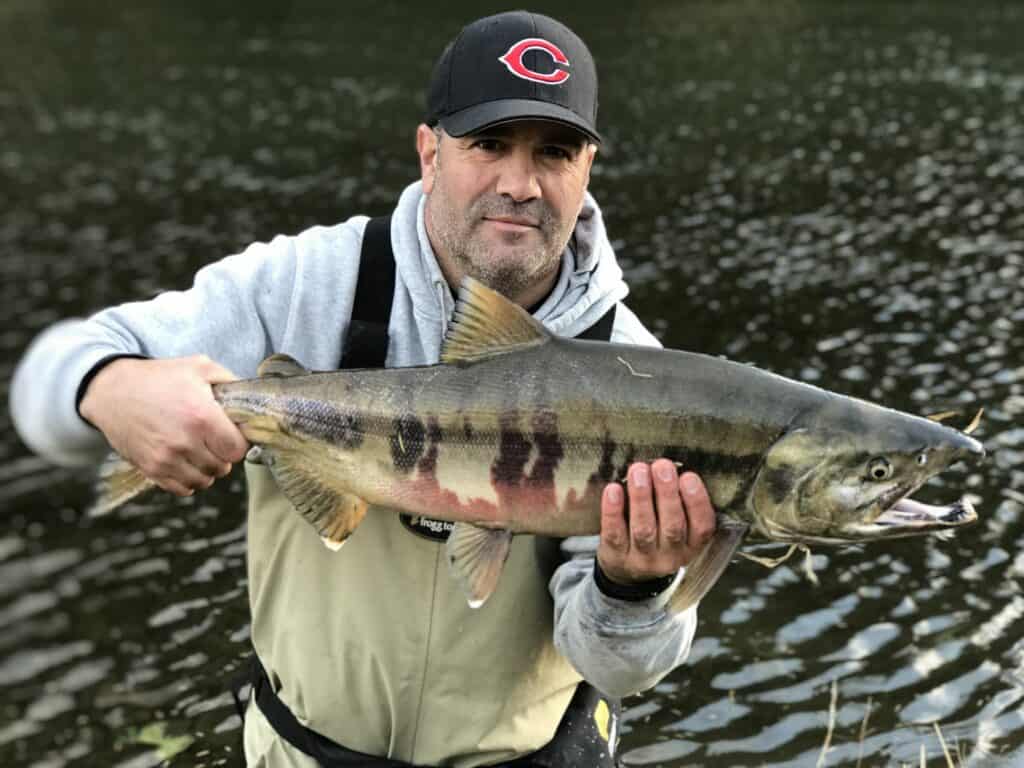
The final salmon on the list is the chum salmon, which are found in coastal areas from northern Oregon into Alaska.
While bigger than sockeye and pink salmon, coming in roughly the same length as a coho with a burlier build, they develop large canine-looking teeth during the spawn.
Their nickname of dog salmon may be due to this toothy appearance, or perhaps to the fact that native peoples knew they aren’t the tastiest salmon around and often fed them to their working dogs.
Commercial fish companies will often market chum salmon with other names, such as keta and silverbrite, but I’ve eaten them silvery and I’ve eaten them with a bit of color closer to their rivers. I’ve smoked them and I’ve grilled them.
All I can say is, I personally prefer any of the other Pacific salmon species for table fare.
That said, chum salmon are strong and relentless battlers that will make your muscles burn and may actually strip the gears in your reel or even snap your fishing rod. Come prepared for a fight.
Chum spawn in many of the same systems as other Pacific salmon, but they tend to stick closer to the ocean in low-gradient rivers and streams, as they aren’t likely to climb many rapids or leap barriers to get to spawning grounds.
Chum salmon also can spawn in large numbers in relatively accessible locations, so depending on the location they can provide entertaining viewing or some good action on a rod.
Salmon Fishing Tackle
Salmon fishing gear comes in many sizes and flavors, just as the salmon themselves.
Rods need to be long enough to get a good distance on rivers while still having enough backbone to bring the bigger ones to net.
Whether you are casting from shore or a boat, each technique will require a specific tackle and bait.
Salmon fishing takes patience and practice. Using the proper setup will help immensely in your pursuit.
Salmon rods vary greatly in length, from 8 feet or longer for bank rods, and often a bit shorter and stouter for boat rods.
We will dig deeper into tackle later on. Each technique has its own tackle requirements.
How to Catch Salmon
We’ll divide up the how-to section into types of waters where you are most likely to fish for them, from rivers to lakes to saltwater bays and oceans.
Fishing for Salmon in Rivers
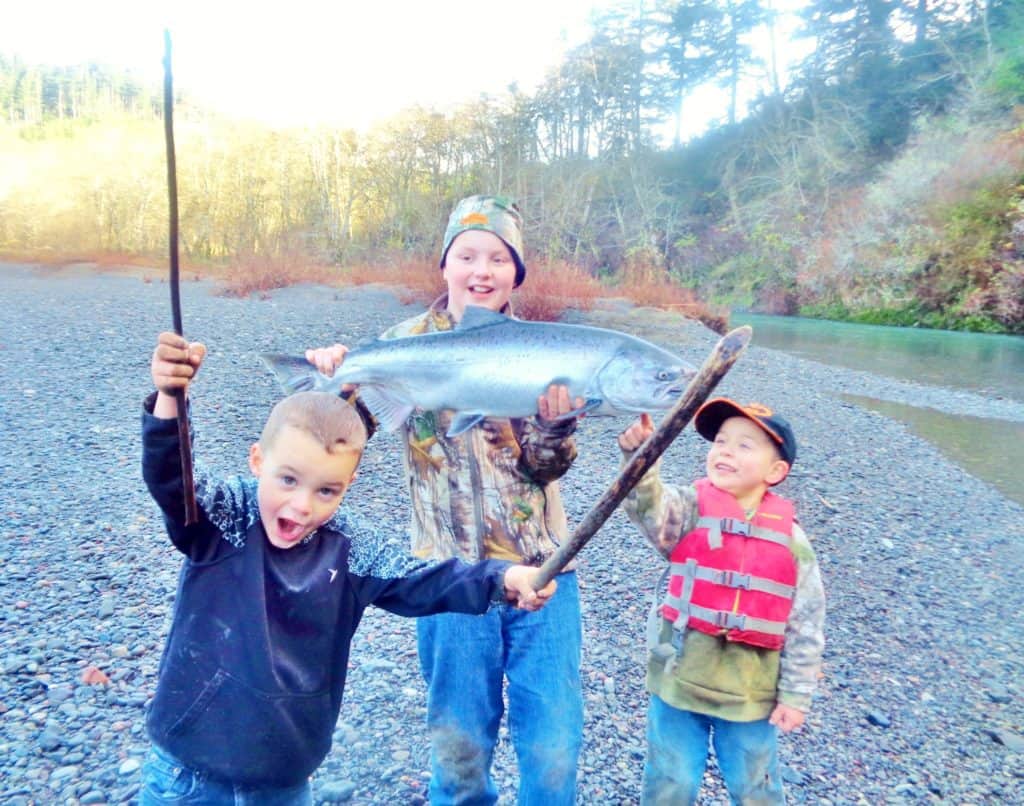
River fishing for salmon has different approaches than bay or ocean fishing. While ocean fishing can be incredibly rewarding, rivers provide many benefits not available to ocean run salmon.
First, river fishing from the bank on your own is significantly less expensive unless you already own and maintain your own fishing boat.
Taking a guided salmon fishing trip can be a surer way to learn how to catch salmon and actually bring one home, but such trips can be quite pricey if you plan to fish often.
River fishing also allows you the convenience of quick access.
Salmon rivers are spread throughout the West Coast and all around the Great Lakes region. It’s far more efficient to hit a river for a few hours after work than going out on the ocean or massive lakes.
Drift Fishing
One of the more popular approaches to catching most species of salmon is drift fishing, especially for anglers fishing from the bank.
Cast your bait upstream and let it drift down through the run. Once it is below you and out of the run, cast it back upstream.
Try to cover the entire pool from side to side until you pinpoint the best holding water. Work your bait from the closest side out to the farthest side and from the top of the pool to the bottom.
Using a proper drift setup will keep your bait bouncing along with the current. The gear used is usually an approximately 9-foot, medium action rated for 30-pound line.
For larger salmon like Chinook and chum, your main line might be in the 20- to 30-pound test range, but smaller species can be landed with 10- to 15-pound test.
While there are many variants, the basic setup is a snap swivel on the mainline with a 24- to 48-inch leader tied to a single hook.
A Corky or similar drift bobber on the line above the hook and a bit of yarn on the loop of the hook, and you’re ready for a weight.
Pencil weights are great options because you can add a rubber cover on the swivel and insert the weight into it. Slinky weights are another great option and tend to hang up less often, as you’ll want to fish these rigs right near the bottom where the salmon usually hold.
Finally, many salmon anglers use bait, including cured salmon roe clusters, sand shrimp or other offerings. With some species, especially Chinook, good bait can really make the difference between getting skunked and coming home to grill.
Side Drifting
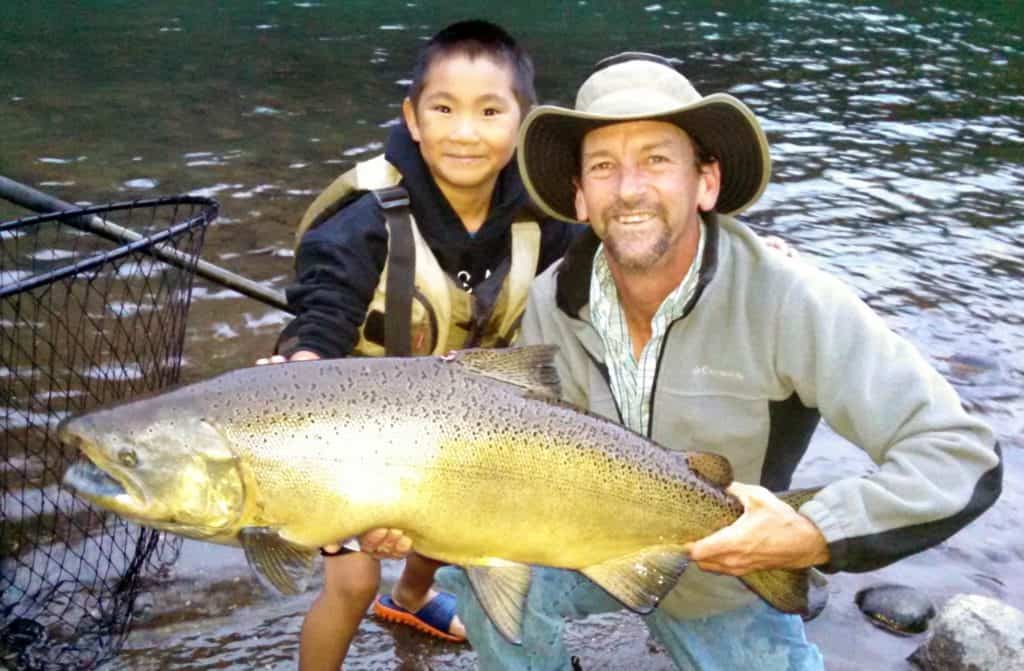
Side drifting is a variation on drift fishing.
Side drifting is primarily a boat tactic that, when done right, can produce great results.
The idea is to take a simple setup and cast as the boat drifts down through the hole, covering more water. If there are multiple anglers in the boat, make sure everyone is working with the exact same setup.
Cast upstream and let your line drift until it is just out of the run or pool, then cast up again. Work from the shore out into the pool, making sure to cover all of the water.
Plunking
Plunking is rather like bait fishing in a lake. You cast your bait into a spot that likely has salmon moving through it and let your bait sit until something picks it up.
A common lure used for plunking is the KwikFish.
Using a 9-foot extra heavy action rod with heavy line (50-pound line isn’t too heavy for this), you’ll attach a swivel or a slider to connect a 4- to 6-foot leader.
The leader is then connected to the KwikFish, which you then wrap with a fillet of baitfish, such as sardine. Tie a second leader around of 2 or 3 feet in length and attach it to a weight heavy enough to hold your offering in one place.
Now that you are set up, it’s time to chuck that lure out into the active fish lanes.
Once you’ve cast out, let it sit until you decide to change lures, or you catch a fish; one or the other should happen eventually.
If you are using thinner spoons, you can use lighter action rods, but generally speaking use larger rods for larger waters.
Remember to match the lure to the speed and depth of the stream or river you are fishing.
Salmon like brightly colored baits, so when selecting spoons for plunking, search for chartreuse and fluorescent colors like pink and orange.
Plunking is more common from the bank but also can be done from a boat.
Read the water before casting and try to target the calmer pools above faster sections. Salmon tend to hold in these calmer waters after pushing through riffles.
Larger rivers need a different approach. Target the edges of the main channel where the water is a bit slower. Salmon are going to look for the easiest way upriver, and they love to hold around cover when available.
Bobber or Float Fishing
Slow-moving or slack water calls for a special approach. Tidewaters and big eddies are perfect examples of when float, also called bobber, fishing works best.
Bobber fishing needs a longer rod.
The usual lengths are 10 to 12 feet with floating line.
The setup uses a sliding float, weight, and a 2-foot leader tied to the bait or lure.
Use a bobber stop to set the sliding float at a specific depth. The fish are usually at a certain depth, so the more time your bait is in their face, the better.
Salmon hang out suspended above the bottom at night, moving to the bottom when the sun comes up. You will need to adjust your bobber stop to accommodate the depth changes.
Bring along salmon eggs and sand shrimp if targeting Chinook, or jigs like the Marabou jig for pinks and cohos, or for very clear, low water.
Trolling
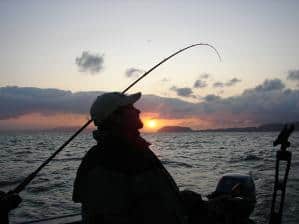
Trolling is a great way to catch sockeye, kokanee or other salmon in lakes, but it’s also a technique used to catch anadromous salmon, especially in large rivers.
The standard setup is usually 20- to 25-pound test line and a 4- to 8-foot leader.
There are a variety of lures that work well when trolling for salmon, depending on the species and location.
Cut plug herring work well, especially closer to saltwater areas, while wobbling lures, spoons, spinners and others, sometimes in combination with baits including sardine or herring fillets or prawns.
Trolling at specific depths can be achieved by using planing boards, downriggers, divers, or weights.
The boat then maintains a constant speed and trolls the bait through the runs until fish are found.
In-line flashers are popular for trolling rigs to help attract salmon.
Casting Spinners and Spoons
Spinners and spoons can be great for salmon under the right circumstances.
These are a personal favorite, because I can carry a box of spinners and another with spoons in a fanny pack without lugging a bunch of bait and tackle.
Let’s break down spinners and when to use them, followed by spoons.
Spinners
Salmon like large casting style (weighted) spinners, although smaller sizes can work best in clear, shallow water. Think of spinners when targeting water that is less than five feet deep.
Bright spinners that produce a lot of vibration are often ideal.
Salmon aren’t actively feeding on their spawning runs, so they need to be provoked into biting. Luckily, in a world where smaller fish steal their eggs and larger fish take over their nesting grounds, salmon are often aggressive to interlopers.
Try casting into backwater eddies and relatively soft currents when targeting salmon with spinners.
The retrieval speed will vary depending on water depth and speed. Strong currents need a slow retrieve. Keep the spinner as close to the bottom as you can to maintain in the strike zone as long as possible.
When fishing in rocky waters, snap your wrist at the start of your retrieve. The quick pop will help avoid snags and get the blades spinning properly. This tried and true approach will help keep your spinner when fishing in cover.
Salmon like things to be a little twitchy. Add some variation and direction changes to your retrieve, and you’ll be more likely to entice a strike.
Keep in mind that just because salmon may be large, their strikes might not be.
Learn the feel of a spinner on your line. If the pulsing feeling stops, or it feels like you’re pulling it through mud, set the hook. You may have just experienced the slackline bite.
Salmon sometimes will follow spinners across multiple currents in order to strike.
Clear water is perfect for bright, light-colored spinners. Cloud cover and low light situations call for darker colored spinners.
Spoons
Salmon fishing with spoons can be highly productive.
Tackle companies have created so many different styles and types of spoons, and it seems everyone has a personal favorite.
One spoon that has been successful for years is the Little Cleo from Acme. It mimics a fat, injured baitfish.
Salmon aren’t eating during the spawn run, but these spoons seem to bring the aggressive nature out in them.
The Kastmaster is another excellent spoon for salmon and works on a wide range of gamefish. Casting a Kastmaster is always a pleasure, particularly if the spoon is an ounce or more.
The retrieval speed is going to vary based on the conditions on the water. Sometimes a simple drift is ideal, sometimes a low and slow retrieve works, and at other times require a fast, twitchy, aggressive return.
Experiment while on the water until you find the right approach.
Once you are zeroed in, you can start in the shallower water near the shore, then move out a few feet, continuing until you cover the entire section of water.
Wobbler Fishing for Salmon
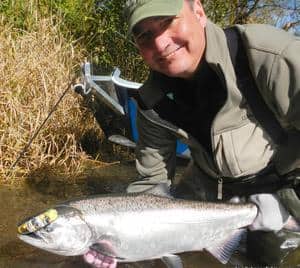
Wobbler fishing is a great option for targeting deeper holding salmon.
Chinook tend to stick to stay near the bottom in deeper water. Therefore, you need to get your bait down to them. Enter the wobbler.
A wobbler setup typically consists of a five-foot weight dropper line and a five-foot leader.
Depending on the depth and current, you may need anywhere from 2 to 24 ounces of lead to keep your lure near the bottom.
The action of the wobbler brings success.
On large rivers closer to the ocean, you may encounter a tidal shift that can influence the speed of the wobbler significantly. You need some current to impart the proper action, so you don’t want an incoming tide to effectively slacken the water, but water also can be too fast for these lures, so learn the sweet spot.
Anchor Fishing
Anchor fishing is a pretty straightforward approach. The idea is to drop an anchor and use KwikFish or another type of plug wrapped in bait in areas that need lead to get to the bottom.
Chinook will aggressively chase a properly fished plug like a KwikFish or a Flatfish. Wrapping it in bait and tossing it out there will slow down the action of the plug and spread scent in the water.
Back trolling is another tactic that works well and lets you slow down on the drop-offs where the salmon are holding.
Great Lakes Region Salmon Fishing
The Great Lakes hold large quantities of salmon that have been transplanted from the Pacific Northwest, along with Atlantic salmon.
There are some amazing rivers from Michigan to New York that can hold large salmon runs.
With the number of salmon that fill these rivers, the number of anglers on the shores can be overwhelming. Always remember good angling etiquette.
Fishing these runs takes much the same approach as those in the Pacific Northwest. While there will be different baits and approaches for each river, the basics remain the same.
Here’s a quick breakdown at the different types and how they are commonly targeted.
Chinook salmon are generally targeted during the early morning and later evening. There are also anglers that target them after dark with glow-in-the-dark spoons. Artificial baits work well, as do salmon eggs and cut baits.
Coho are the most prevalent type in the region and are targeted using spoons, spinners and plugs. These fish give a great fight and can be targeted year-round in the lakes.
Pink salmon can be caught in the deeper waters off the coast as they stack up, preparing to head up the rivers.
Downriggers work well when targeting pinks, as does jigging with spoons. The best time to target them is the few weeks prior to the beginning of the run.
Atlantic salmon are usually targeted by trolling with downriggers.
However, some anglers will drift fish with soft-plastics and jerk baits along the sides of the pools below the rapids on the rivers.
Drift fishing works the same on these rivers as it does in the Pacific Northwest.
Fly Fishing for Salmon
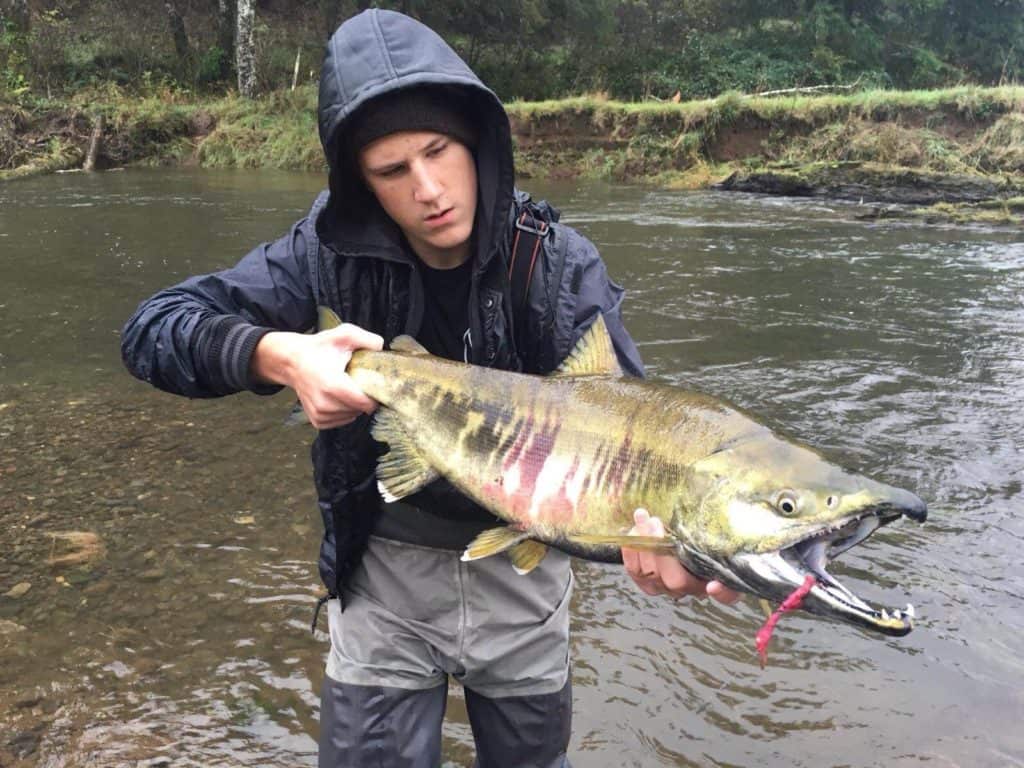
Fly fishing for salmon can be an epic adventure, depending on the type you are targeting.
Coho and Chinook may be amenable to a well-placed streamer if it gets deep enough and is brightly colored.
Sockeye are on the other end of the spectrum. They won’t actually attack a fly, so a common technique is to pull the line through their mouths, hooking them with the fly.
Equip yourself with a solid rod. Double handed is the only way to go since your standard trout rod is going to give way five minutes into the fight.
A good 13-foot rod will help with casting distance and provide the necessary backbone to battle a salmon for up to 25 or 30 minutes it might take to bring it to the net.
There are fly reels specifically designed for salmon. Get one with an additional spare spool. Start with a floating line and put a sinking line on the spare.
A small salmon fly is around a size 10 or 12. Carry a good number of flies, ranging from size 12 to size 2.
Bring a few larger, heavy streamers that will get down deep fast. Chinook are going to be more interested in larger, deeper flies. Silvers may respond better to shallower, smaller flies.
Coho are going to give you the most entertaining fight on a fly. They act more like a trout or steelhead than any other salmon. Acrobatics and aerial leaps are common with silvers.
Leaders are critical with salmon fishing.
The accepted norm is that salmon leaders need to be correspondingly longer with smaller flies. Smaller flies also require a significantly lighter tippet.
In clear water, you will want the lightest tippet you can get away with and still land fish.
Large flies, like streamers and heavy tube flies, require much shorter leaders. Three feet should work. Any longer, and you are bound to get tangled up on every cast.
Fishing for Salmon in Lakes
Certain salmon will hold in lakes. Sockeye will live for a year or more in lakes before migrating to the ocean, and the returning adults can be targeted in some lakes.
Kokanee are abundant in select lakes throughout the Western states.
There are certain areas that are more prominently targeted for lake run sockeye, like Baker and Wenatchee lakes in Washington, where fishing techniques are similar as they would be for kokanee, but perhaps with slightly bigger tackle.
Additionally, several state fish and wildlife agencies, including those in Washington, Oregon and California, have found good success planting Chinook and sometimes coho salmon into large lakes and reservoirs.
When the lakes don’t have a clear path to the ocean, these salmon will often remain in the lakes and grow to impressive sizes, though on average a bit smaller than those that can gorge in the ocean.
The most popular way to go after salmon in lakes is trolling.
Kokanee and sockeye often respond to small or medium-sized spoons, spinners and hootchie-style lures, often with a piece of bait on the hook.
Look for lots more tips on landlocked sockeye fishing in our easy guide, Kokanee Fishing: Simple Techniques and Tips.
Those overall types of lures mentioned for sockeye and kokanee also can work for freshwater Chinook and coho, often in larger sizes. Wobbling plugs and crankbaits imitating smaller fish these salmon eat are often popular choices.
Depth is the key. Salmon in lakes often hold fairly deep, frequently deeper than trout in the same lakes, and you won’t catch them by trolling over their heads. You may need a downrigger, diver or at least extra weight to reach them.
Flashers are helpful as they draw more attention to your presentation. Speed and depth are going to vary by location, but a good setup will work pretty universally.
Fishing for Salmon in Saltwater
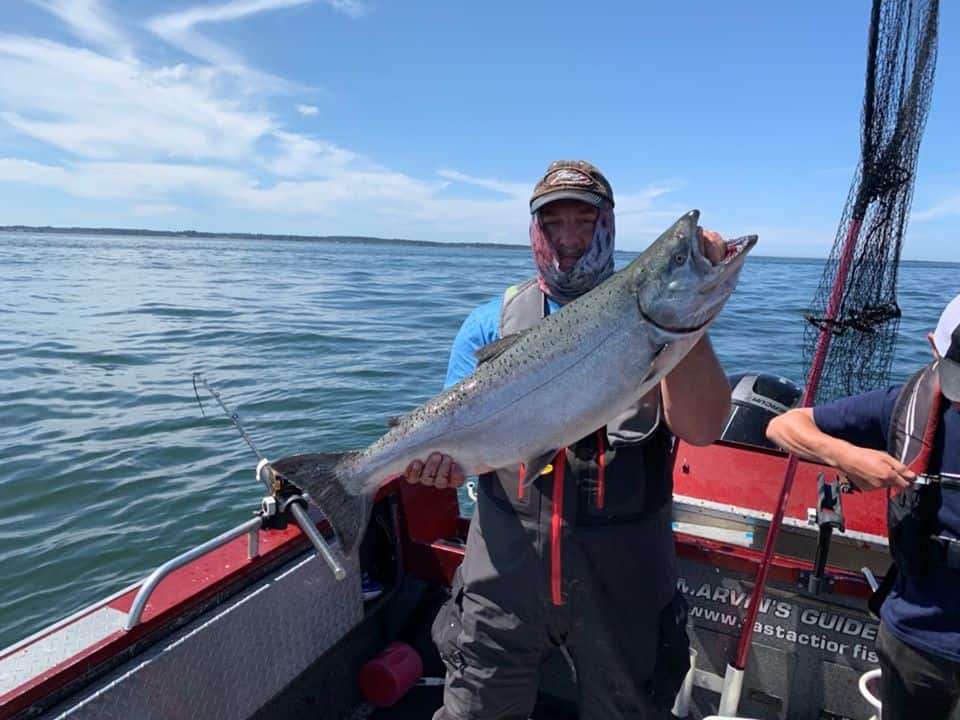
One of the biggest challenges for saltwater salmon fishing is locating actively feeding fish. Using a fish finder might help, but there are other things to be aware of as well.
One trick is to watch for the birds. Birds know where the baitfish are and will congregate in tight groups while the baitfish are around. Once you find the birds, the salmon are sure to follow.
Once located, watch the bird’s behavior. They might just hang out for quite a while before actively feeding.
As you watch, you’ll also notice several other boats are pulling up doing the same thing. Trolling through the area should pay off, but timing it can be difficult.
Trolling is very effective, and using a downrigger is the preferred method unless salmon are running near the surface, and coho sometimes will.
The setup for this technique is pretty straightforward. Tie a barrel swivel to your mainline, then add around six feet of heavier monofilament line to your flasher, then around two feet of lighter fluorocarbon below the flasher.
Tie the lure or hook on, add cut bait, and you are ready to go.
A major benefit to using a downrigger is that you get to fight the fish without having to fight the added weights as well.
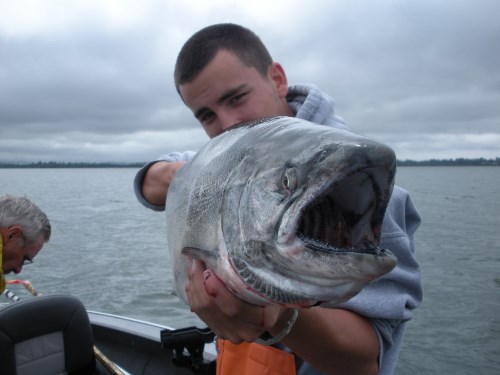
There are other setups you can use, both with and without weights, but downriggers tend to be one of the easier setups to use.
An excellent go-to bait is a plug-cut herring. Plug cutting is basically cutting the head off the bait at an angle just behind the gill plate.
There are plug-cut guides you can purchase that will make cutting the right angles much easier.
The angle of the cut directly corresponds to the tightness of the rolling motion the bait makes, and that rolling motion makes your bait look like a wounded baitfish ready to be eaten.
Fishing for salmon with spinners or plugs made for trolling also can be very productive.
There are several strategies that an experienced saltwater angler may deploy when trolling, so consider using a charter or guide for your first trip to learn what works. It will pay off in more salmon in the net and fewer headaches.
Another technique that can be very successful is mooching. Mooching is basically taking your bait, dropping it to just below the depth the salmon are at, then reeling in slowly all the way up to the surface.
Inland waterways and bays are great places to focus your search. Bays will hold salmon that stage as they prepare to head up rivers to spawn. Time it right, and bays can provide pretty fast action.
Trolling with bait or lures is also a common tactic in bays, but you likely won’t have to fish as deep.
Depending on water depth, casting spoons and spinners in bays can be exciting, active fishing. Shallower water is ideal for this approach. Puget Sound offers several ideal locations for shallower water fishing.
Smaller bays and inlets with a tributary river are likely to have salmon in tighter conditions. Targeting them by casting lures can be very productive.
Tidewater areas where salmon often pause just before swimming into rivers also can be good using bait such as cured salmon roe under a bobber.
If you aren’t getting bites but have marked salmon, put some scent on your lure. Even cut herring can have more scent added to bring all the salmon to the yard.
Overall, keep actively searching for baitfish in deeper water, try mooching when stationary, and cast lures or bait in shallower waters. These techniques will typically deliver a few fish to the net when the salmon are biting.
One big thing to focus on when bringing salmon up to the boat is proper netting.
There isn’t much worse than having a nice salmon on your line, fighting it hard, and losing it at the net. Having a charter or guide will help you learn net handling.
Salmon can have fairly soft mouths, and in many waters, you are required to use barbless hooks so that they can slip the hook at the worst possible time.
Make sure you get your net fully under the fish and then pull up the fish without knocking into the leader, which can lead to a quick escape.
What Now?
This article introduced you to many of the most effective ways to catch salmon in rivers, lakes, bays and the ocean.
That’s a topic worthy of many books to cover fully, so this is meant as a taste to get you started.
From here, you can seek out more specific information on fishing techniques, fish with a guide or other experts and, most of all, put in your time on the water to learn how to catch these magnificent fish.
Best Salmon Fishing
Click the following states to find the best salmon fishing in each location. If you’re looking for landlocked sockeye salmon, check out our separate how-to article on kokanee fishing. We are currently in the process of adding more states.

